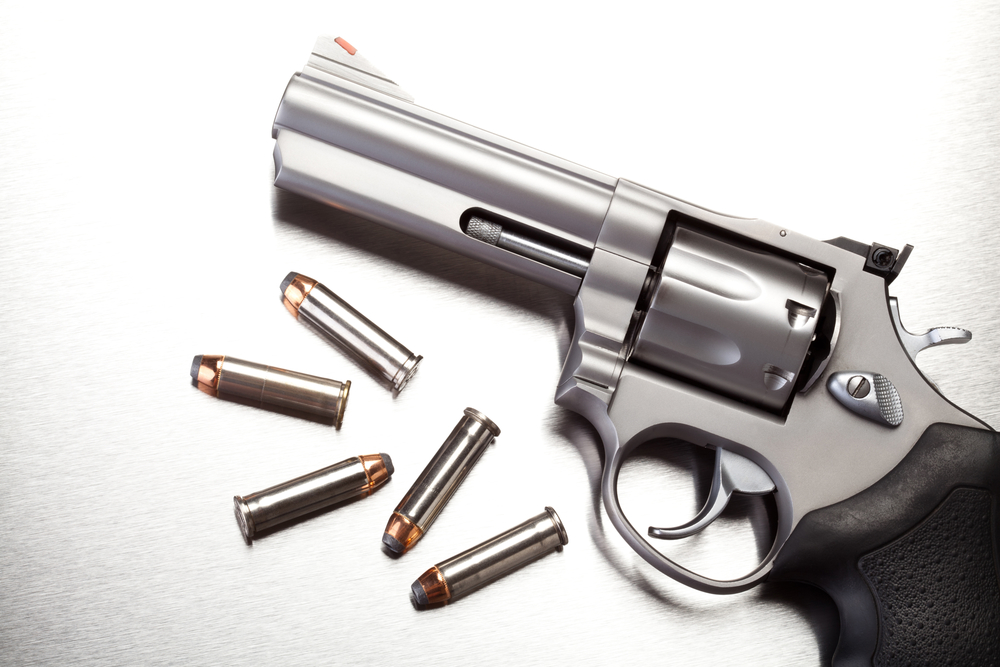

More and more people are buying guns on the internet these days, and as a result, more people are wondering how to ship firearms in the United States. Believe it or not, federal and state governments allow for the shipment of certain firearms. However, there is a long list of rules and regulations one needs to follow in order to ship them. It’s a touchy and complicated subject, but let’s give it a shot! See what we did there?
Table of Contents
- Do You Need a Federal Firearms License?
- Shipping Firearms with an FFL
- Shipping Firearms Without an FFL License
- Properly Packaging Firearms
- Which Carrier Should I Use to Ship Firearms?
- Shipping Firearms Internationally
Do You Need a Federal Firearms License?
First thing’s first: if you want to ship firearms in the United States, you may need to obtain a Federal Firearms License from the Bureau of Alcohol, Tobacco, Firearms and Explosives (ATF). This license designates the individual holding it as operating a legitimate and lawful business that complies with the ATF. An FFL license allows licensees to run their firearms-related businesses, and to ship and receive firearms in compliance with local, state, and federal laws. Firearms dealers, manufacturers, importers, and repair technicians are all required to hold an FFL license.
Shipping Firearms with an FFL
You can ship guns to any state in the United States if you have a current, valid FFL license. However, if you are shipping a firearm outside of your state, your recipient must also hold a current, valid FFL. Make sure your recipient either faxes, emails, or mails you a copy of their FFL license certificate. Once you confirm their license, you can only ship to the person and address listed on the certificate.
You can ship to recipients without an FFL license only if they are within your state. When you do so, be sure to run an extensive background check. Your recipient CANNOT be any of the following:
- A felon
- Convicted of domestic violence
- A subject of a domestic restraining order
- A fugitive
- An unlawful user of a controlled substance
- An undocumented worker
- A dishonorably discharged veteran
- A former U.S. citizen who has renounced their citizenship
- Declared mentally deficient or involuntarily committed to a mental institution
Shipping Firearms Without an FFL License
You can also ship guns without an FFL license, but it comes with restrictions…and a whole lot more of them, at that. The ATF refers to people without a valid FFL licenses as non-licensees. The three major carriers have different policies for shipping firearms without an FFL license. USPS has the most regulations and restrictions for this scenario. However, shipping a firearm with USPS can be done if you don’t have an FFL license. We’ve outlined how to do so in the sections below:
You Can Ship a Firearm to Yourself in Another State
You can ship a firearm to yourself in another state, but only for the purpose of “hunting or engaging in lawful activity.” In this case, you’ll need to address it to yourself, and only you can take possession of the package. Therefore, you need to make sure you’re at the destination when it comes.
You Can Ship Firearms to Another Nonlicensee Only In Your State
The Postal Service allows nonlicensees to ship firearms to another nonlicensee in the same state. However, USPS prohibits the shipment of handguns and pistols without an FFL license. If you’re a nonlicensee and you wish to ship a handgun in the same state, you can’t use USPS…and all other carriers will require you to ship the gun through an FFL holder or directly to an FFL holder.
You Can Ship a Firearm to Another State Only if the Recipient Has an FFL License
This one is pretty self-explanatory. Note that the FFL holder you sent the package to will only release the firearm to the recipient once they complete ATF Form 4473 and the National Instant Criminal Background Check System (NICS).
Properly Packaging Firearms
On top of restrictions on the process of shipping firearms, laws also govern how you need to pack firearms for shipment. Basically, the main idea is to pack it so that no one can tell that a gun is inside, and to ensure it arrives at its destination safely and undamaged. Here are the steps to properly packing firearms, laid out for you below:
Use a Strong, Brand New Corrugated Box
First, start by making sure your box is new, sturdy, and has plenty of room for packing material to cushion and protect the firearm. This is the first step, no matter which carrier you choose for shipping firearms. The carriers are strict about this. For example, UPS requires you to use a new, corrugated box that meets their single-wall strength guidelines.
Learn more about UPS’ requirements for packing and labeling firearm shipments.
No Markings on the Box Can Indicate a Gun is Inside
Federal law prohibits any markings on a package that indicate a gun may be inside. Therefore, it’s best to ensure that the exterior of your box is totally blank. In fact, this law is the reason why so many firearm shipments are packaged as a box within a box (kind of like a Russian nesting doll). This prevents drawing any unwarranted attention from criminals such as gun thieves when your package is in transit.
This regulation also applies to printed shipping labels. Any shipping labels on the box must be non-descriptive.
Do Not Include Ammunition
Before you throw bullets into your package, don’t jump the gun! You CANNOT include any ammunition inside the same packaging as your firearm. Since they are considered explosives, bullets and ammunition are categorized as ORM-D materials. Therefore, you’ll need to ship ammunition in its own separate package. This also goes without saying, but FIREARMS CANNOT BE SHIPPED IF THEY ARE LOADED!
Learn more about how to package and ship ammunition.
Use the Right Protective Packing Material
Pack, pack, pack! Always use the proper packing material to keep your firearm safely in place and protected during transit. We suggest using plenty of bubble wrap, packing tape, styrofoam, and sturdy packing paper to fill empty space inside the box. Custom-molded foam inserts are the best kind of packing material for shipping firearms, if you can get your hands on some. A good way to test if you’ve packed your firearm properly is to pick up the package and see if you notice any movement or rattling inside. If you do, then we suggest giving your box some extra packing love.
Insure Your Firearm Shipment
We always recommend you protect your package with shipping insurance whenever shipping firearms. That way, you’ll rest easy knowing you are covered in the event that any damage occurs to the firearm during transit. You can purchase additional coverage either from your carrier or through a third-party insurance company. Note that certain third-party insurance companies may not cover firearms, but some companies such as Shipsurance do. In addition, your carrier might not insure your package if it isn’t packaged properly—so don’t make that mistake!
Check With Your Carrier
When you’re ready to ship, always check with your carrier to make sure you packaged everything correctly. They will inspect your parcel and be able to catch things you might have overlooked so that your firearm arrives at its destination promptly and in good condition.
Which Carrier Should I Use to Ship Firearms?
Which shipping carrier you choose depends on the kind of firearm you wish to ship, and if you have an FFL license. While USPS allows nonlicensees to ship long guns (such as a shotgun) to other nonlicensees, USPS restricts the shipment of handguns and pistols to FFL license holders. USPS also doesn’t allow for the shipment of short barrel rifles or shotguns that can be concealed on a person. That being said, USPS is a good option if you have a valid FFL license. If you need to ship a handgun or pistol without a FFL license, your best bet is to use UPS.
While you can use FedEx, we recommend UPS over FedEx in this case. FedEx has similar policies, but UPS has more experience in the area, and for what it’s worth, actually handles the majority of shipments ordered off the National Rifle Association’s online store.
As always, check with your carrier to make sure you’re in compliance with their rules and regulations before shipping! No matter which carrier you ship with, you will need to provide proper government identification and documentation.
The UPS Services You Need to Use
UPS only allows you to ship firearms and handguns with their next-day services. You have three options for shipping them, and we’ve laid out those services below:
- UPS Next Day Air
- Next Day Air Early
- Next Day Air Saver
Once you’ve selected your service, here are a few other things to note before shipping with UPS:
- You can only ship firearms through a UPS Scheduled Pickup Account using various UPS pickup services, or through a UPS Customer Center (aka counters at UPS operational facilities)
- You cannot ship them via UPS Drop Boxes or UPS On-Call Pickup, and you can’t drop off firearm shipments to locations of The UPS Store, any third party retailer, or any UPS Access Point location
- Lastly, you must verbally notify the UPS driver or UPS Customer Center clerk that you’re shipping a firearm containing a handgun
Learn more about sending firearms with UPS.
Shipping Firearms Internationally
You need a valid FFL license if you wish to ship firearms internationally. If you have a license, the first step is to register with the Directorate of Defense Trade Controls. You’ll need to pay the registration fee and complete the DS-2032 Statement of Registration Form. Forms typically take between 45-60 to process, after which you will receive a confirmation email. Next, you are required to fill out the ATF’s Application and Permit for Permanent Exportation of Firearms (ATF Form 9).
We also recommend you do your research on the laws of the nation you plan on exporting firearms to. Some nations such as Canada prohibit the importation of firearms, even if the individual has a license to own the firearm. Lastly, always check with your carrier regarding their international policies for shipping firearms.
Too Much Information to Process?
If all of this information is making your head spin, we won’t judge! Shipping firearms is a complicated subject. If you feel like you need some help, you can always employ a FFL holder to help you ship your firearm. You’ll need to pay for their services, but it’s worth it if you want to ensure the entire process is legal and above board. It’s true what they say: you get what you pay for.
For more info from UPS directly, check out their firearm shipping guide on their website.


Christian Maphis
Thank you very much for an extremely informative well written article on shipping firearms! Could use a few more specific details shipping through FedEx and UPS regarding Long guns but overall very informative and very helpful article!